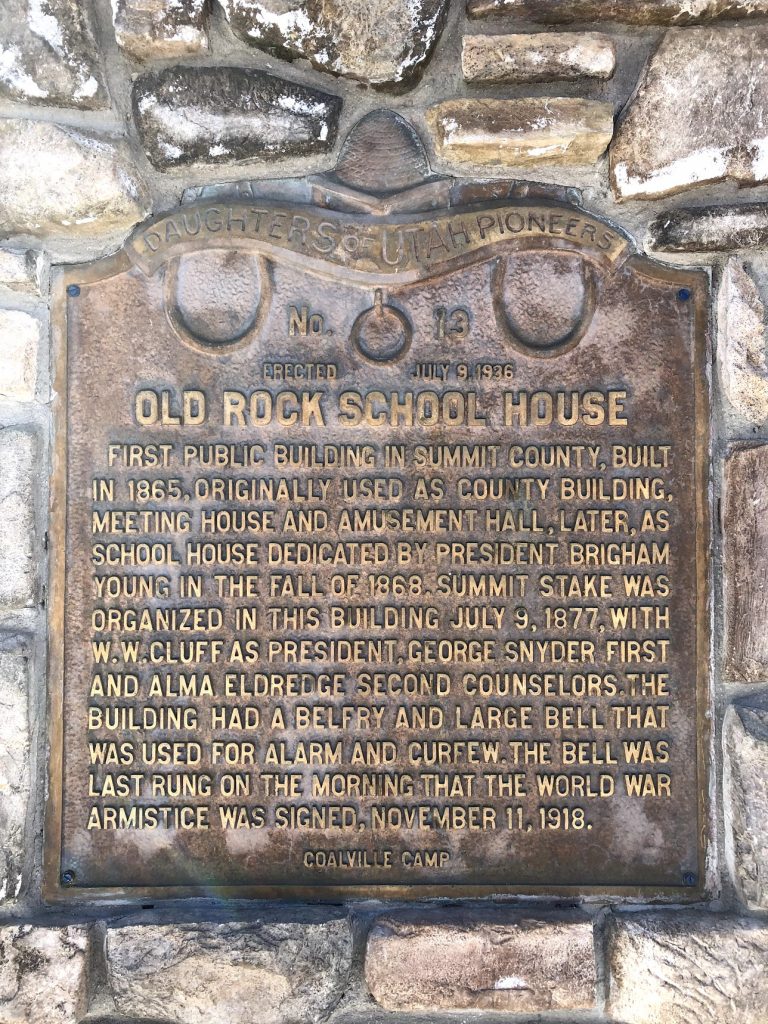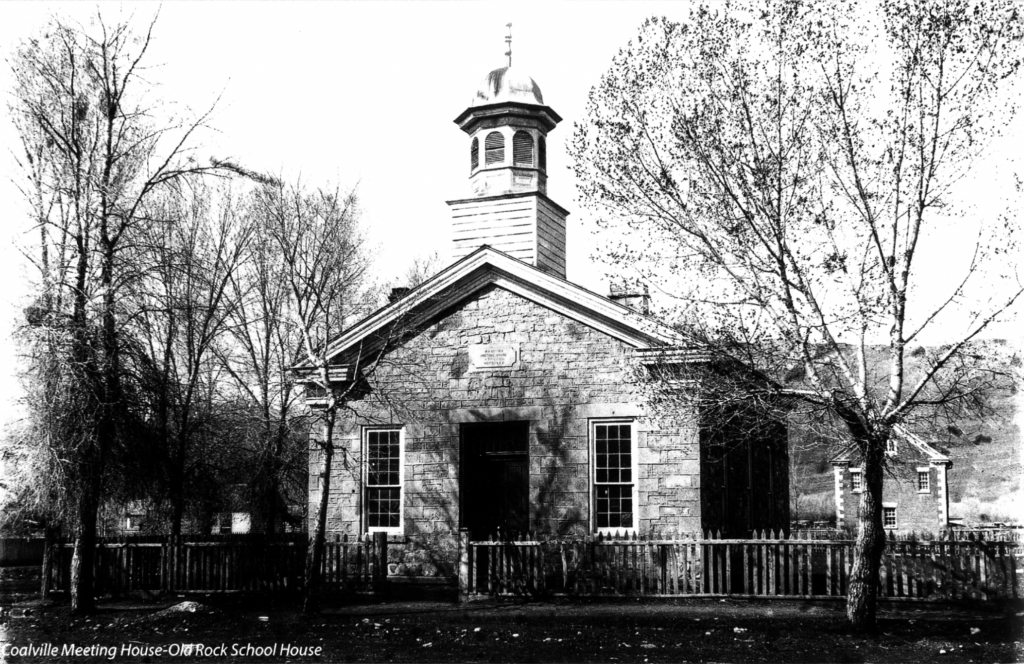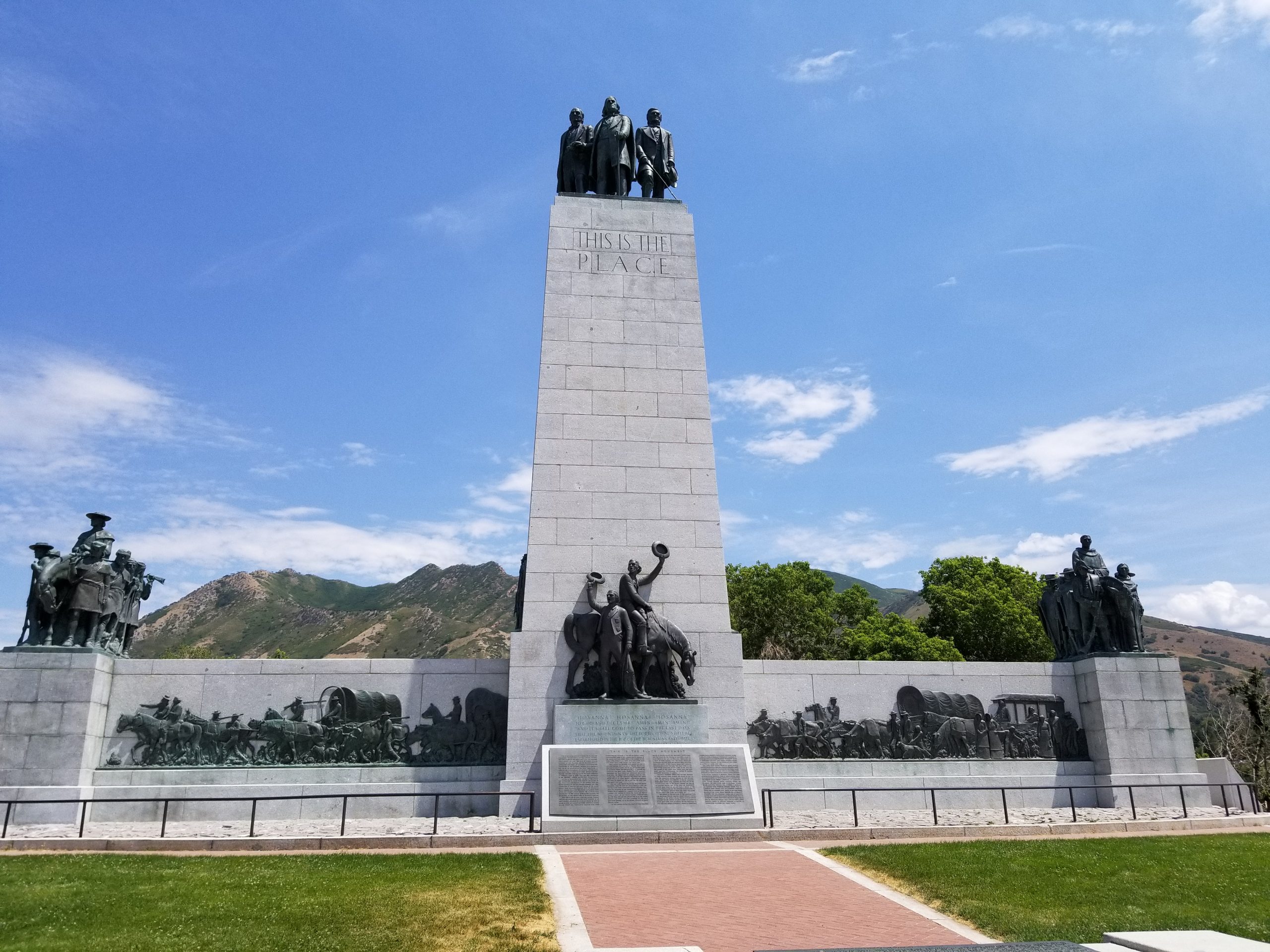Placed by: Daughters of the Utah Pioneers, No. 13
GPS coordinates: 40.9142194 degrees north, -111.3975917 degrees west

Historical Marker Text:
First public building in Summit County, built in 1865, originally used as county building, meeting house and amusement hall, later, as school house dedicated by President Brigham Young in the fall of 1868. Summit Stake was organized in this building July 9 1877, with W.W. Cluff as President, George Snyder first and Alma Eldredge second counselors. The building had a belfry and large bell that was used for alarm and curfew. The bell was last rung on the morning that the World War Armistice was signed, November 11, 1918.”


Extended Research:
In its early years as a settlement, the people of Coalville used a small log cabin for a school and meeting house for religious services. From 1864 to 1865 the community banded together to build a new, larger building to accommodate their growing numbers. Settlers donated whatever labor, time, and supplies they could spare to the effort.[1] Fredrick Wilde owned land in Coalville and wanted a church to be built there. He and many others helped to build what became a regional church building for members of the Church of Jesus Christ of Latter-day Saints who lived in the Summit County area, also called the Summit Stake House.[2]
Near the chosen location for the new building was a ledge of stone which the builders decided to use in constructing their new meeting house. Thus, the finished structure came to be known as the “Rock Church,” “Rock Chapel,” and “Rock School House.” Lumber, however, was not as readily available and had to be brought from Sawmill Canyon, approximately 10 miles away, up Echo Canyon. One settler, William H. Smith, donated ox teams to the effort of hauling stone to the site and to collecting logs from canyons while other settlers donated labor at the saw mill.[3]

Photo provided by NaVee Vernon, Summit County Historian, January 2019
When the building was completed in 1865, the community began to use it as a church and school house. A small, one room structure, the Rock School House was built with a belfry, which housed the bell used to call school children to their lessons. The bell was also used as a warning sign to the community, in which cases the building was used as a refuge. The Rock Church was further used as a social and amusement hall for parties and dances. It sometimes became a government center for the county as well, where “laws and rules were formulated [to] govern the people.”[4]
In September 1869, a few years after its completion, Brigham Young, President of the Church of Jesus Christ of Latter-day Saints, dedicated the building. On September 24th the Deseret Evening News reported that at the time it was being built, many thought it would be too large, but after it was finished, due to population increase, the community had already outgrown its Rock Church. “It is a chaste, elegant building,” the News reported, “beautifully finished, and it is a credit to the place.” During his trip to dedicate the building, President Young counselled the Bishop of Summit and Morgan counties, W.W. Cluff, “to take steps to build a larger meeting house… and when done to use the present building for a schoolhouse.”[5]

The bell was last rung on November 11, 1918, otherwise known as Armistice Day, when the bell signaled the end of World War I. The small building continued to be used as a social hall and later as a seminary for the Church of Jesus Christ of Latter-day Saints until 1975 when it was sold to Lagoon’s Pioneer Village where it stands today with its original furniture on display.[6]

Rock Chapel Sign Text:
The Pioneer Village Little Rock Chapel has as fascinating a history as any building in Utah. Originally located on Main Street in Coalville, it was constructed in 1863 as a fort against the Indians, and was used in more than one attack. When the Indians became friendlier, the building became a courthouse with the jail attached to it. Later as the area grew, it was turned into a schoolhouse and became the center for social activities in the Coalville area. Finally, in 1869, the chapel was dedicated by Brigham Young as an LDS church. It retained its importance as a meeting place for both social and political activities in the community. Constructed of hand-drilled, hand-cut blocks of Summit County sandstone, the chapel contains the original pews, pot-bellied stove and lectern. Paneling and pews were wood-grained to simulate hardwoods. This was commonly done through this period, when only softwood was available and the appearance of hardwood was more desirable. This church is a unique and lovely reminder of Utah pioneer heritage.
[1] Rhea M. Bagnell, “The Old Rock School House in Coalville”, Personal History. Provided by Summit County historian NaVee Vernon.
[2] Louisa Wilde Ballantyne, “Our Book of Remembrance,” A History of Fredrick George Wilde by Louisa Wilde Ballantyne. January 01, 1970. Accessed February 05, 2019.
[3] Bagnell, “The Old Rock School House in Coalville”, Personal History.
[4] Bagnell, “The Old Rock School House in Coalville”, Personal History.
[5] “Editorial Correspondence,” Deseret Evening News, (Salt Lake City, Utah), 24 September 1869, 2. Utah Digital Newspapers, accessed March 16, 2019.
[6] Walter Lee, “The Old Rock School House,” Issue brief, compiled by Mary Andersen, Daughters of the Utah Pioneers. Provided by Summit County historian NaVee Vernon.
For Further Reference:
Primary Sources:
- Bagnell, Rhea M. “The Old Rock School House in Coalville”. Personal History. Provided by Summit County historian NaVee Vernon.
- Ballantyne, Louisa Wilde. “Our Book of Remembrance.” A History of Fredrick George Wilde by Louisa Wilde Ballantyne. January 01, 1970. Accessed February 05, 2019.
- “Editorial Correspondence.” Deseret Evening News, 24 September 1869, 2.” Utah Digital Newspapers. Accessed March 16, 2019. h
Secondary Sources:
- Lee, Walter. The Old Rock School House. Issue brief. Compiled by Mary Andersen. Daughters of the Utah Pioneers. Provided by Summit County historian NaVee Vernon.
- Coalville School Bell and the Old Rock School House. Daughters of The Utah Pioneers. Provided by Summit County historian NaVee Vernon.
Other sites you may be interested in visiting:
- Rock Chapel – Lagoon’s Pioneer Village – Farmington, Utah – This Old Church on Waymarking.com
- Coalville History
- Coalville City
- Old Rock School House on The Historical Markers Database
